Healthy Family
How to Choose the Best Sunscreen
From your primary care doc to your child’s pediatrician and every healthcare provider in between, there’s one piece of medical advice you’re bound to hear more than once this summer: wear your sunscreen! So, why is this protective layer so essential and, more importantly, how do you choose the sun protection that’s best for you? We break down the best ways to protect your skin this summer with this guide on how to choose sunscreen.
Understanding Sun Protection Basics
It’s important to start with understanding the sun’s rays and how they affect your skin. There are two types of harmful ultraviolet (UV) radiation—UVA and UVB. You can think of the difference as long-lasting damage versus quick blasts. UVA rays are longer and penetrate deep into the skin, causing wrinkles and other accelerated aging factors. UVB rays are shorter and typically harm the outermost layers of the skin, causing everyone’s least favorite aspect of summer—the sunburn, which in-turn can lead to skin cancer.
Keeping those rays at bay requires Sun Protection Factor or, more commonly, SPF. This rating measures how well a sunscreen protects your skin from ultraviolet rays, primarily the UVB rays that can lead to sunburn. In addition to the SPF, using broad-spectrum protection will help protect your skin from both UVA and UVB rays.
As a quick general rule, look for broad-spectrum sunscreen with an SPF of 30 or higher. Re-apply liberally and often, at least every two hours or more frequently if you’re in and out of the water.
Key Factors to Consider When Choosing Sunscreen
Your Skin Type
Finding a sunscreen that works well with your skin type is important to its efficacy and your comfort. The better sunscreen feels on your skin, the more likely you are to apply it before you walk out the door. Look for a sunscreen designed to work well with your skin type.
- Dry skin: Opt for sunscreens that offer extra hydration.
- Oily skin: Try an oil-free brand or lightweight option or a sunscreen with a matte finish that’s less likely to clog pores.
- Sensitive skin: Avoid anything with fragrance or harsh chemicals. Look for hypoallergenic formulas or chemical-free sunscreens created for children.
While people with darker skin can be less prone to sunburn, they’re certainly not immune from it and still need to apply sunscreen frequently. Again, use broad-spectrum with an SPF of 30 or higher, regardless of skin tone.
Your Lifestyle and Activities
 Different summer days require different sunscreen options. Standard daily activities such as going to work, running errands or playing at the park don’t need more than a daily wear sunscreen. Find one that works well and feels good on your face and apply first thing in the morning and then again throughout the day. Look for something slightly sturdier and intended for full-body use for other exposed skin. But if your day veers from standard into summer adventure, you’ll probably need sunscreen designed for outdoor play.
Different summer days require different sunscreen options. Standard daily activities such as going to work, running errands or playing at the park don’t need more than a daily wear sunscreen. Find one that works well and feels good on your face and apply first thing in the morning and then again throughout the day. Look for something slightly sturdier and intended for full-body use for other exposed skin. But if your day veers from standard into summer adventure, you’ll probably need sunscreen designed for outdoor play.
As summer temps rise, nearby watering holes beckon. Lake, river, stream or pool, water can quickly wash away your sunscreen if it’s not applied correctly. No sunscreen is waterproof, but there are a variety of water-resistant options out there that typically last 40 to 80 minutes. If you’re spending time getting wet, make sure to find a sunscreen designated as water-resistant and apply liberally. Also make sure to put on sunscreen at least 15 minutes before you dive in to prevent the gel or lotion from simply washing away.
If you’ll be spending full days outside, supplement sunscreen with lightweight, breathable, sun-protective clothing. Look for a UPF, or Ultraviolet Protection Factor, rating on clothing tags. These fabrics are designed to help protect skin from sun damage, and they can be cooling and more convenient than reapplying sunscreen frequently.
Sunscreen Formulations
The first rule of choosing the right sunscreen is to find one that fits your lifestyle and feels good on your skin. Sun protection is typically split into two categories—chemical or mineral. Chemical sunscreens absorb UV rays that reach your skin and then release them whereas mineral sunscreens create a barrier between the sun and skin. Mineral sunscreens typically use zinc oxide or titanium oxide. Chemical sunscreens rely on organic compounds such as avobenzone, oxybenzone, octocrylene, homosalate, octisalate or octinoxate. If you have sensitive skin, you might be better off with mineral-based protection. If your skin is more tolerant, then a chemical sunscreen can feel lighter on the skin’s surface.
Lotions, sprays, sticks and powders—it’s hard to know which one works best. Typically, dermatologists recommend lotions, creams or sticks for maximum staying power, coverage and absorption. Sprays are convenient, but it’s hard to know how well the skin is covered and not everyone loves the aerosol effect. Powders work well for touch-up areas or applying over makeup on the face or neck and can be a good option for people with oily skin.
Special Considerations
If you’re not sure where to start when choosing the best sunscreen, it’s worth a conversation with your dermatologist, or you can opt for trial and error. Important considerations include:
- Sunscreen designed for face versus the body: Facial sunscreens are specially formulated for more delicate skin, can be more expensive and come in smaller quantities.
- Makeup compatibility: Again, a powder sunscreen might be a good option if you’re frequently applying over makeup.
- Children’s sunscreen needs: When covering up the youngest members of your crew, choose sunscreens created for kids, which are usually easier on sensitive skin and designed to create a hearty barrier for active play.
- Sunscreen for specific conditions: If you have specific skin conditions that might react to sunscreen such as acne, eczema or rosacea, talk with your doctor about the best options for you.
Reading Labels Like a Pro
 Make sure you get your money’s worth when you buy a bottle of sunscreen by identifying key features on the label and ingredient list.
Make sure you get your money’s worth when you buy a bottle of sunscreen by identifying key features on the label and ingredient list.
Active ingredients to look for in mineral sunscreens include titanium dioxide and zinc oxide, both of which reflect UVA and UVB rays. Active ingredients in chemical sunscreens can include:
- avobenzone
- oxybenzone
- octinoxate
- homosalate
- octisalate
- octocrylene
Make sure your sunscreen isn’t expired; it can become much less effective if it is. A good rule is to simply replace your sunscreen stash at the start of every summer to ensure everything is up-to-date and nozzles and applicators are bacteria-free.
While these marketing claims might make you feel better about your purchase, be wary of the following:
- Waterproof or sweatproof: According to the FDA, there is no such thing when it comes to sunscreen.
- Natural, organic or chemical-free: There isn’t an official regulation for these in the cosmetics industry so these claims can be misleading.
- Reef-safe or reef-friendly: Some sunscreens are formulated to be kinder to marine life, however, there is no current standard to define these specific criteria.
Common Sunscreen Mistakes
As summer heats up, make sure to avoid these sunscreen flubs!
- Applying too little sunscreen. Don’t be afraid to lather up and look pale in your pursuit of sunshine fun.
- Forgetting to re-apply. Set a timer on your watch or phone to re-apply sunscreen at least every two hours; more frequently if you’re at altitude, near water or sweating.
- Relying on makeup SPF alone. These applications can offer some protection, but typically not enough to ward away UVA and UVB rays for long.
- Ignoring often-missed spots. Ears, eyelids, tops of feet, lower legs, lower back and shoulder blades, lips, tops of hands, scalp, neck and ears—don’t neglect them!
Conclusion
If it’s a sunny day, make sure you’re protecting your skin with the proper sunscreen type and application. You can always consult with your pediatrician or dermatologist for the most up-to-date info on sunscreen! Sun protection offers life-long benefits, not to mention happier, sunburn-free summer days.





